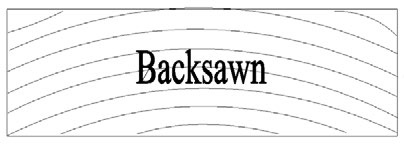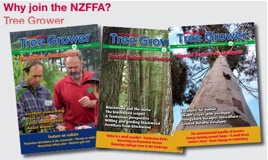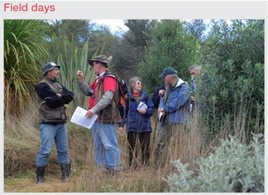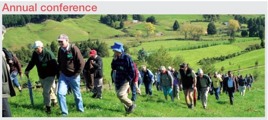Lucas portable sawmills
Ian Schulz, New Zealand Tree Grower August 2013.
If you are involved in farm forestry and are thinking of buying a sawmill to process your own logs, then you should start by establishing a market. The three main markets are for appearance grade, structural grade and the remaining products such as wood pellets. Appearance grade would almost always give you the best value per cubic metre, but there is a higher production cost.
The best practice is to always have more than one option so that you establish which logs are best suited for higher value products with the rest. Two questions that should be asked are about size and cutting patterns. Knowing the section size to be cut will help to make a decision on what type and size of portable mill to buy. Remember, it is easy to over-invest when starting out and bigger is not always better.
Cutting patterns
Backsawn and quartersawn are terms used to describe two common cutting patterns within the timber industry, which simply refers to the placement of growth rings. When measuring shrinkage, a backsawn board has a tangential face and a quartersawn board a radial face, as shown in the diagrams.

Backsawn boards have growth rings generally going from edge to edge. To be backsawn, growth rings have to be less than 45 degrees to the face of the timber.

Quartersawn boards have growth rings generally going from face to face. To be quartersawn the growth rings have to be greater than 45 degrees to the face of the timber.
Why backsawn?

A backsawn cutting pattern is faster because there is generally less straightening cut required. Wide board availability when backsawn is almost double that of quartersawn out of the same log. When you consider that a hardwood board has to be heart-free, and many hardwood species are susceptible to borer and have to be free of sapwood, the section size is reduced even more.
To produce a quartersawn board you have to saw radially, which means the widest board possible is only from the centre to the outside. Another effect on the section size of a quartersawn board is growth stress, particularly when sawing hardwood.
Growth stresses



A backsawn cutting pattern will give better recovery. The difference when sawing eucalypts is around 10 per cent and the main reason for this is growth stress movement. To produce a straight backsawn board it is a simple matter of balancing out the growth stresses – this board will have bow but no spring. To produce a straight quartersawn board you have to relieve all the growth stresses and then re-saw it – this board will have spring but no bow.
Every log varies on how much the board will move from the intended straight line, although 50 millimetres is not uncommon and this has to be removed. To balance the growth stresses on a backsawn board, simply imagine a horizontal and vertical line running through the heart on the end of the log and then produce the board with the same amount of wood on each side of the line.
To balance growth stresses, the saw must be set parallel to the heart in both horizontal and vertical. Bow is where the timber is bent through the thickness and spring is where the timber is bent through the width. Bow is generally easier to straighten than spring. Softwoods do not tend to move as much in sawing.
Other advantages to backsawn timber
Growth stresses are common in all trees and are there to help support and prevent them from falling when subjected to wind. During the growing stage of the tree the root system and diameter of the tree are not large enough to support the tree in strong winds, so all around the tree its cells are stretched longitudinally. When the tree is subjected to wind, the stretched cells only allow the tree to bend so far before being pulled back into position.
If the tree has longitudinal tension, it also has to have a longitudinal compressional force when a cut is made into a log longitudinally. What was being stretched will relax, and what was being compressed will expand. As a result of these two forces, the board will bend away from the intended straight line.
Nailing is better
Backsawn timber has a better nail-holding ability, particularly in softwood. As trees grow they add growth rings on to their diameter with one year’s growth made up of two bands, one darker than the other. The darker band consists of summer, autumn and winter growth, and is a lot denser than the other, which is formed during spring growth.
With fast-growing softwood it is common for it to add 10 millimetres or more on to its diameter. On a quartersawn board with growth rings running from face to face, a nail can go through the low-density earlywood. With softwood the nail has to go through the latewood as well, otherwise the nail can be pulled through the board.
With eucalypts loose gum veins and shakes are laid on top of a growth ring and do not accrue radially, so a backsawn board is less likely to have a loose gum vein or shake extend from one surface to another. Splitting when nailed, and the orientation of loose gum veins and shakes, are two of the main reasons why railway sleepers are traditionally backsawn.
Faster drying
Backsawn timber will dry faster than quartersawn. However, this is not necessarily a benefit as the faster the timber dries the more prone you are to drying defects. Softwood is not as prone to surface checking, and due to softwood timbers poor nail-holding ability and often small diameter, a backsawn cutting pattern is generally used.
In most cases, when cutting hardwood for structural purposes and sleepers backsawn cutting is used. Quartersawn is generally used for appearance grade timbers.
As the tree matures it has no need for growth stresses and they relax, but the tree may have to be over 100 years old before this occurs. The faster the growth of the tree the more it will move and a small diameter will move more than large diameter. Movement can be reduced by storing logs underwater, which can prevent drying degrade.
Why quartersaw timber
Quartersawn timber is easy to match. As the growth ring orientation on a quartersawn board runs face to face this means you are looking at the growth rings on their edge. This makes it easy to match the appearance of two boards when joining them, even from different logs, as long as they are the same species.
Backsawn timber, on the other hand, has growth rings running from face to face and this means you are looking at the curvature of the growth rings. This on a single board or wide slab can look magnificent, but glue two together and you will always notice you have two boards.
Due to different shrinkage rates a quartersawn board is more stable. It has a radial shrinkage across the width, as opposed to a tangential shrinkage across it. Radial shrinkage is generally half that of tangential shrinkage. This means that a quartersawn board will experience half the shrinkage during the drying stage and dry board is less prone to movement as a result of seasonal changes to humidity when dry.
Drying and checking
There is far less drying degrade on a quartersawn board. The two main drying defects are cupping and surface checking. A quartersawn board will not cup. You can see collapse, which is also a drying defect that occurs when the cells collapse as the moisture is removed. However, this can be corrected by steaming before the final drying process.
Surface checking occurs as the surface dries out and shrinks. The faster the surface dries the worst the checking will be. Surface checks occur radially, meaning surface checks travel through the growth ring towards the heart. A quartersawn board will have surface checks on the edge. This means jointed boards will be glued together and the checks will be hidden whereas a backsawn board will have them on the face. Most surface checking will not affect the structural strength of the board but it does have an effect on the appearance.
A quartersawn board wears better.
When using a portable mill such as a Lucas mill the sawing pattern in the diagram would produce quartersawn. Due to growth stresses in a lot of hardwood logs, to produce straight timber you will most likely be required to cut slabs and then re-saw them.
What to consider in a portable mill
To produce straight timber by balancing growth stresses you need to set the saw parallel to the heart in both horizontal and vertical planes. Some sawmills allow independent adjustment at both ends of the log and others require the log to be lifted. Lifting logs with cranes, forklifts and jacks will have an effect on production.
To achieve the best recoveries by sawing parallel to the heart, and when needed parallel to bark, you need to be able to adjust the sawmill at both ends. Some sawmills require the logs to be rolled to produce backsawn and quartersawn. You need to decide if the sawmill be used for re-sawing? Some sawmills are limited to what diameter can be handled.
Lucas Mill produces six different circular swing-blade machines, ranging from a four-inch model up to the versatile 10-inch model. Options are available for each model including slabbing, planing, sanding and weatherboard attachments. The portable sawmills are capable of cutting large diameter logs with unlimited cutting length, and can be transported to almost any location to select harvest timber with minimal effect on the surrounding environment.
Ian Schulz is Technical Advisor at Lucas Mill based at Wooragee in Victoria, Australia.

 Farm Forestry New Zealand
Farm Forestry New Zealand

